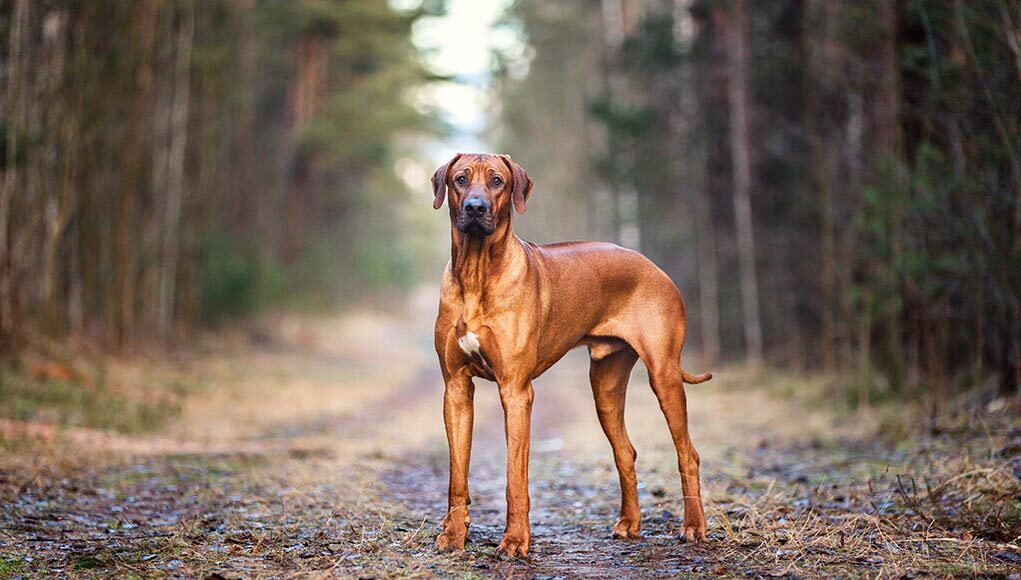Table of Contents
Strong, balanced, and athletic. These are the three main characteristics that I can think of when I see a Rhodesian Ridgeback dog breed.
Have you ever seen a dog run for 30 miles without a sweat? That’s the Rhodesian Ridgebacks for you.
This breed is powerful and impressive. Also known as the African Lion Dog, this breed was famous for hunting Lions.
The Rhodesian Ridgeback puppies originated from South Africa. This breed was made by the Khoikhoi people.
The Rhodesian Ridgeback was a mix of imported Bloodhounds, Great Danes, Greyhounds, Mastiffs, and Terriers.
This breed was first used to remove smaller pests in the villages and eventually started hunting for bigger animals.
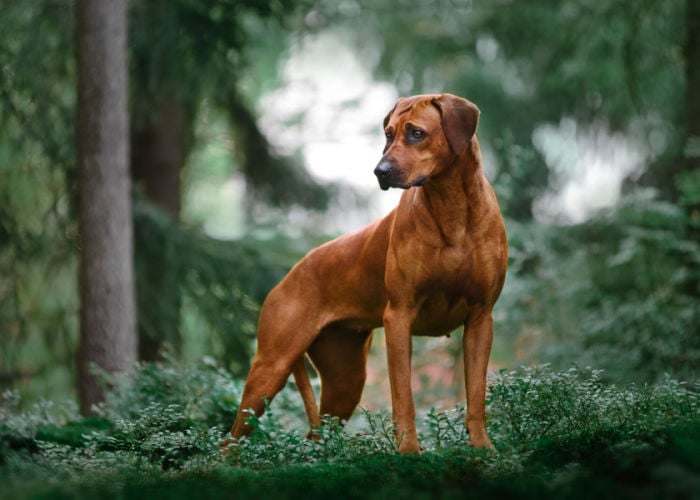
Rhodesian Ridgeback: Physical Traits
The Rhodesian Ridgeback is a tall, muscular and robust dog breed. This breed has one of the best symmetrical features.
Male Rhodesian Ridgebacks can stand from 25 to 27 inches and may weigh up to 80 pounds.
In comparison, the female Rhodesian Ridgebacks can stand from 24 inches to 26 inches and may weigh up to 70 pounds.
The Rhodesian Ridgebacks are short-haired. Their coat comes in Wheaten colors; it’s either Light Wheaten, Red Wheaten, or Natural Wheaten.
Rhodesian Ridgebacks have no known color markings. They should be solid single-colored fur.
However, some cases of Rhodesian Ridgebacks have white or black markings.
The most unique trait of the Rhodesian Ridgeback is its Ridge. The Ridge is a straight and long portion of the fur growing opposite direction from the rest of the body.
The Ridge must have two (2) crowns, symmetrical tapering down the back of the body, and must be prominent.
The Rhodesian Ridgebacks are round, black, and parallel to each other. Their nose may come in black, brown, or liver in color.
The Rhodesian Ridgebacks have a well-developed muzzle with a beautiful bite.
These dogs have long and durable forelegs, and it also has well-developed muscles surrounding them.
The Rhodesian Ridgeback’s feet are also known for their unique features: arched toes and compact, elastic-padded, and thick feet.
The Temperament of a Rhodesian Ridgeback
This breed is significantly protective. They will do their utmost best to provide security and safety for their family.
Thus, they may be too protective at times. They can be trained to be more comfortable and confident rather than them being anxious.
The Rhodesian Ridgebacks are amazing companions for families. They’re not the best around children as they are hyperactive when they get too excited.
As mentioned, Rhodesian Ridgebacks are quite protective of their family and may not easily welcome strangers. It will take time for Rhodesian Ridgebacks to accept strangers.
Owners may try to leave a scent of the stranger at their home so Rhodesian Ridgebacks may get familiar with it.
This goes the same for other dogs. Rhodesian Ridgebacks may not be as friendly at first sight. They may become easier if we're able to receive early exposure and socialization.
Although they hunted big animals, they still tend to chase other animals. So it’s best not to have small animals running around Rhodesian Ridgebacks.
Rhodesian Ridgebacks will do amazing in homes with big backyards, fields, or farms. Since they’re quite active, they have some space they can run to and release their energy.
They may not be the best to be in smaller homes or apartments, but as long as they can get their daily exercise and training needs, they will do just fine.
Rhodesian Ridgebacks are not known to be barkers. If they do, it’s best to inspect the situation with caution.
It’s best not to leave this breed alone, as they may get frustrated and bored. And when they do, they will find anything that will entertain them until it does not anymore.
Rhodesian Ridgebacks are very adaptable to warm weather as well.
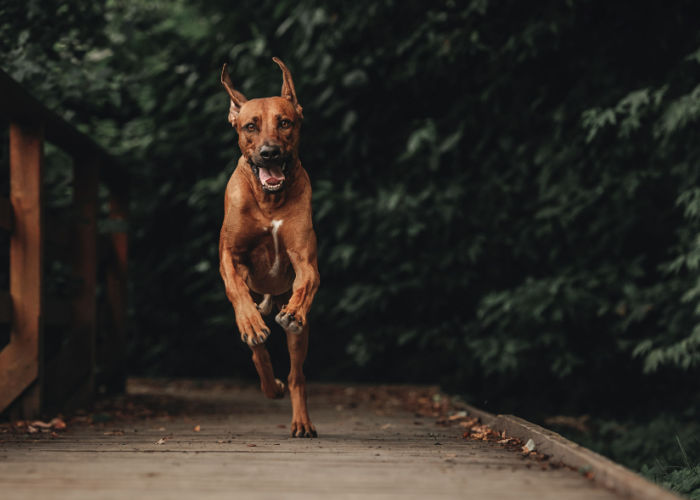
Training
Rhodesian Ridgebacks need to have continuous physical and mental stimulation. It’s also best to introduce them socially to other dogs and humans while they’re young.
This is because this breed has a huge tendency to become domineering, and that’s not good.
These intelligent and athletic beasts do not easily back down. So exposing them to different environments can help them develop their social skills.
Owners can use training activities that let their Rhodesian Ridgebacks think more. Food puzzles and other problem-solving activities are perfect for Rhodesian Ridgebacks to be more patient.
Rhodesian Ridgebacks tend to have mouthing and jumping behavior. Since they’re huge and heavy dogs, the mouthing tendency can be dangerous when they become adults.
Although play biting is normal for puppies, it can become more aggressive and painful as time progresses.
They may even develop this play bite as an impulsive response to a sudden stimulus. It may even harm the owner or family and, in worst-case scenarios, children.
Rhodesian Ridgebacks also have a great tendency to be domineering which may make it difficult to train them when they’re adults. It will take great patience for both the owner and the dog.
Owners may have a difficult time training their Rhodesian Ridgebacks alone, so they may ask for a professional dog trainer for guidance and lessons with their dog.
Exercise
In terms of exercising, although they have moderate energy levels, the Rhodesian Ridgbecks need a daily vigorous exercise regimen.
This dog is particularly and naturally extremely active. If their energy and necessary exercise needs are not met, they may become destructive at home.
The Rhodesian Ridgebacks are extremely intelligent and may get bored when it comes to repetitive activities.
Owners can spice things up with different activities every now or then. They can also have their Rhodesian Ridgebacks join the family outing or trips.
They may have playtime in the backyard for 15 minutes daily and a 45-minute walk or run in the park or field.
As long as they can release their energy daily, they are less reactive than they will be at home.
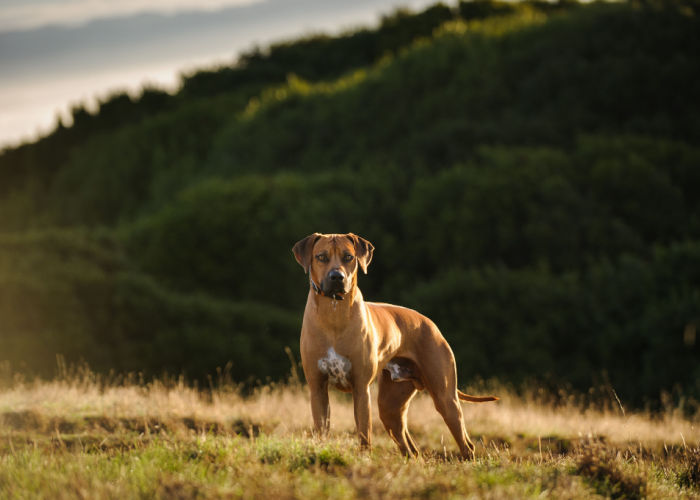
Rhodesian Ridgeback Health Care
The Rhodesian Ridgeback is one of the healthiest breeds out there. They are generally a very healthy breed.
As long they’re well taken care of, check-ups are regularly done, and complications are addressed immediately, the Rhodesian Ridgebacks will experience little complications.
Unfortunately, not all Rhodesian Ridgebacks are fortunate enough to undergo screening before breeding. Some Rhodesian Ridgebacks may have inherited some disease.
Here are the following diseases the Rhodesian Ridgeback may have:
Dermoid Sinus
Also known as Pilonidal Sinas, the Dermoid Sinus is a prenatal condition where the skin and the nervous system was not able to separate due to underdevelopment during the embryonic stage.
This is often located at the back or near the dog's spine. This condition will need surgery as a treatment.
This condition is most prone to Rhodesian Ridgebacks. Dogs with Dermoid Sinus must not be bred as this can be inherited as well.
Elbow & Hip Dysplasia
Dysplasia is a genetic condition wherein the socket of the joint and ball becomes distorted.
Rhodesian Ridgebacks are prone to elbow and hip dysplasia due to their large stature. Their mass stresses their lower body areas, especially in their joints.
When diagnosed with Elbow or Hip Dysplasia, it’s important to keep their weight in the normal range and have them exercise with activities that promote joint therapy.
Veterinarians may prescribe medications for anti-inflammatory/ pain relievers and supplements.
Prevention is the same, keeping them active but not injuring them. A treadmill walk or swimming is perfect for prevention and recovery as well.
Autoimmune Thyroiditis
Autoimmune Thyroiditis is a hereditary disease. The thyroid gland may produce fewer hormones than needed to function.
Drastic weight change, lethargy, darkening skin pigment, excessive shedding, infertility, obesity, and cold tolerance can be the apparent symptoms.
If your dog is diagnosed with Autoimmune Thyroiditis, it may have another disorder. It is best to check it out with the veterinarian thoroughly.
Having it checked out and tested early by the veterinarian is the key to treatment and prevention.
The veterinarian may give medication that may regulate the hormones.
If the Rhodesian Ridgebacks have the following, it’s best not to breed as the offspring may inherit the diseases and affect their quality of life.
With this said, remember to adopt from reputable breeders in the first place.
Remember to have your Rhodesian Ridgebacks checked regularly. It’s also best not to delay treatment and medication for their condition to improve in case of complications.
Diet Needs
Rhodesian Ridgebacks are enormous, and so is their appetite. Rhodesian Ridgebacks can be given 4 cups daily, divided into two meals.
Owners may coordinate their food consumption with their size. Rhodesian Ridgebacks should not be overweight or obese, may it be their still puppies until adulthood, as it may strain their developing joints.
It’s best to keep their diet to be adequate instead of overfeeding them. Rhodesian Ridgebacks are large breed dogs, meaning the heavier they are, the more stress there will be on their joints. This is where dysplasia may take place.
To avoid these, owners must keep treats to a minimum and only when necessary. Owners should also not overfeed their Rhodesian Ridgebacks.
Rhodesian Ridgebacks tend to be greedy when it comes to food. They may try to take food from the table or where there is access.
Owners must train their Rhodesian Ridgebacks from such behaviors to avoid accidents.
If the dog is muzzling their food way too fast and asking for more, owners may search for tips for their dogs to avoid food muzzling.
Remember to keep fresh water accessible at all times. Rhodesian Ridgebacks are exceptionally active and may be dehydrated immediately.
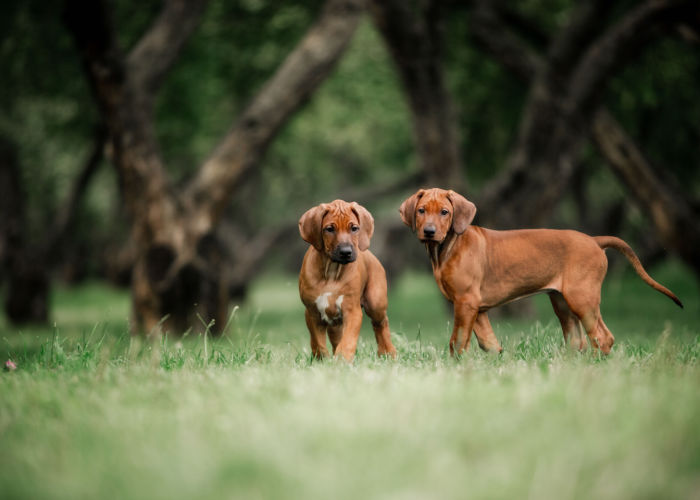
Grooming a Rhodesian Ridgeback
Rhodesian Ridgebacks are also known for their minimal Grooming needs. This breed is known to have an odorless coat.
This breed has dense and short-length hair that sheds rarely. They can be brushed once every two days to remove dead hair and distribute oil to their skin.
The Rhodesian Ridgeback may be bathed once a week or once every two weeks. They should also be bathed after water activities to remove grime or possible bacteria in the water.
The Rhodesian Ridgebacks have their ears flopped down on their face, so they may not dry as often as they should. Make sure to dry their ears after every bath or water activity to avoid ear infections.
Keep the Rhodesian Ridgeback’s oral health in its best shape by brushing their teeth often. Owners may use dental treats once in a while if they can’t accommodate them as needed.
Rhodesian Ridgebacks have large and fast-growing nails. This should be trimmed or filed regularly.
Trimming should only be done if the nails are long, and filing them can be done when sharp.
Some Rhodesian Ridgebacks may be resistant when it comes to some Grooming activities. Owners should introduce these grooming regimens while they’re still young.
Owners should introduce it with positive associations, such as rewarding them with toys or treats after receiving the activity.
Frequently Asked Questions about the Rhodesian Ridgeback Dog Breed
Are Rhodesian Ridgebacks Dogs not good with children?
Due to its size, it’s best not to leave children with Rhodesian Ridgebacks alone. These dogs are very interactive and may get too excited with the child’s energy.
To avoid accidents, make sure to supervise both of them. Rhodesians Ridgebacks will do great with older children. But it’s always best to educate children on handling a dog before anything else.
Are Rhodesian Ridgebacks biters?
Yes, they are naturally biters. You may notice that they tend to react easily to moving hands and may reach for them to bite.
Although while they’re puppies, it may be considered a play bite, but it may become an impulse as they age. So it is advised for owners to have their Rhodesian Ridgebacks train their biting behavior.
Are Rhodesian Ridgebacks a rare breed?
Rhodesian Ridgebacks are relatively rare. They only have 2,000 registered Rhodesian Ridgebacks at the American Kennel Club.
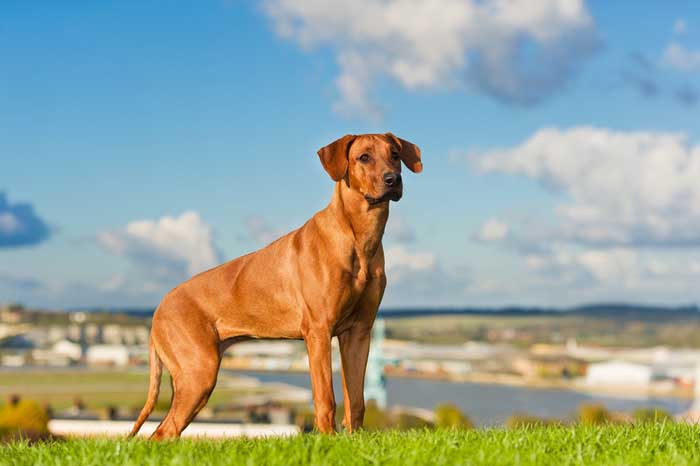
Rhodesian Ridgeback Dog Breed Profile: Summary
Meet the mighty Rhodesian Ridgebacks. Although known for their athletic and hunting abilities, these beasts are big lovers.
Rhodesian Ridgebacks go extreme as they do in the field with their family. They’re protective and very attached to their family.
If you’re an active family, the Rhodesian Ridgebacks are the perfect companion for you!
If you're thinking about adding a Rhodesian Ridgeback puppy to your family, remember that it's better to adopt than to shop.
With proper training and socialization at an early stage, these dogs are great with children. However, training the child on how to behave around the dog is also essential.
If you love to run, this might be the right dog for you, as these dogs love to run as they were once bred to hunt.
They are fast enough to keep pace with some of the fastest dog breeds in the world.


